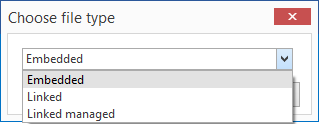You can embed external files into a Tosca workspace. These embedded files are saved directly to the repository.

|
If you use Tricentis File Service, Tosca Commander saves the attached files directly to the file service. In this case, you cannot embed. |
-
Drag and drop the file you would like to attach from the Microsoft® Windows Explorer on the chosen object in your workspace.
Alternatively, a file can be attached via the context menu or the dynamic menu by using the option Attach file.
-
After dropping the file a dialog window is displayed. Select the option Embedded.

Dialog: selecting the file type
-
Confirm your selection by clicking the OK button.
Files, which are larger than 1 MB, require some prior adjustments in the TOSCACommander.exe.config file.
Create entries for the settings MaxEmbeddedFileSize and EmbeddedFileSizeWarningLevel as described in chapter "TOSCACommander.exe.config".
Edit files offline
In addition to the options described in chapter "View and edit attachments", you can also edit embedded files offline in Tosca Commander.
-
Select the option Take offline and edit with... or Take offline and edit from the context menu of the required file.
-
Specify the path for the file to be saved in the subsequent dialog. Depending on what you have selected, Tosca will open your file either with the program defined by Microsoft® Windows, or you can also select the program to be used to open the file manually.
In Tosca Commander the file is marked as offline by an exclamation mark.
After you have edited the file offline, you can choose between the following context menu options in order to newly embed or edit your file:
Bring online
The modifications are applied and the file is embedded again in the Tosca Commander™ workspace. The modified file must be closed before it is embedded.
Cancel editing file offline
The modifications are discarded and the file is embedded again in the Tosca Commander™ workspace.
Edit offline document
If a document has already been taken offline, it can be re-opened and edited with this option. You can define the program to be used to open the document manually if this has not been specified beforehand.
Embed customizations
As an alternative to externally managing a file system, the customizations required for steering can be embedded in Tosca Commander. For this purpose, all required zip files are hierarchically embedded beneath a Module folder.
If several zip files exist, they are used in descending order, starting from the top level of the hierarchy. Within a Module folder, the zip file that has been embedded first (oldest) is commonly used.
At run-time, the zip files found in the hierarchy of the respective Modules are automatically unzipped if required, and the start.bat file is executed. This ensures that the required customizations are available from the respective directories.
For further information on customizations, please refer to the corresponding
Zip file contents
A bat file named start.bat must be created, which performs all the required steps (copying files, registration, etc.).
Example for the content of a bat file:
xcopy "TricentisDotNetBaseControls.dll" "%TRICENTIS_HOME%\dll\DotNetEngine\CustomControls"
xcopy "TricentisDotNetBaseControls_1.dll" "%TRICENTIS_HOME%\dll\DotNetEngine\CustomControls"

|
All files, which are called up by the bat file, should exist in the zip file. This ensures that customizations are entirely versioned via Tosca Commander and that the commands of the start.bat file are simplified by specifying relative paths. |